ORDER
Strigiformes
FAMILY
Tytonidae
GENUS & SPECIES
KEY FEATURES
• Acute hearing lets it \ locate mice and voles in
total darkness by the faint noises they make while moving or eating
• Superbly sensitive binocular vision allows it to spot small mammals on the ground by day or in dim light
• Flies silently — the soft, comblike tips of its wings and its feathered legs muffle wind noise
WHERE IN THE WORLD?
In open grasslands, wetlands and semi-desert in North and South America, the Caribbean, central and southern Europe, much of Australasia and Africa; absent from the far north and much of Asia and Antarctica

Lifecycle
Pale and ghostly, the barn owl patrols silently over fields and grassland at night with slow, effortless wingbeats. It listens for the faintest rustle that betrays its prey.
HABITAT
Open, grassy lowlands with a few trees are typical habitat of the barn owl; this adaptable bird is also found in habitat ranging from arid scrub to farmland and roadsides.
The barn owl avoids dense woodland, which obstructs its flight, and is rarely found in deserts. It avoids mountains and northern regions where snow lies deep for more than a month or so, because prey can hide beyond reach beneath the snow.The barn owl is therefore absent from most of northern Europe and Asia — from northern Scotland to eastern Russia — and from Canada.
The barn owl relies heavily on old buildings for roosting or nest sites; hollow trees, cliffs
and caves are also used.The owl’s decline in recent decades can be attributed in part to the alteration of its habitat, as old buildings are pulled down or modernized and woodlands are cleared, although concerned people are helping by erecting nest boxes.
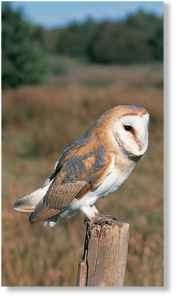
A Ideal surroundings Grassy fields attract the barn owl; they’re a good source of rodent prey.
# After eating, a barn owl coughs up pellets containing undigested parts of prey, such as bones and skull. If pellets are soaked in water for two hours, they may be pried apart to reveal the contents.
The barn owl preys mainly on shrews, voles and mice; prey items recorded from around the world include blind moles, gerbils, hamsters, chameleons, crickets and hawk-moths.
CONSERVATION
The barn owl isn’t endangered, although in many countries it has suffered from poisons used to kill rodents; many also die on roadsides, blinded by headlights.The owl is a valuable ally to the farmer, helping control vermin, but nest sites are disappearing with the steady “tidying” of the countryside.
Barn owls pair for life. Each spring, the partners perform courtship flights, weaving and chasing over fields to renew their bond. They choose a site in a hole in a building, old tree or cliff, although they don’t build a nest. The female lays her eggs (usually four to seven, but sometimes many more) in a hollow, any time from March to August. She lays each egg at one- to two-day intervals, so up to two weeks may pass between the time that the first and last eggs hatch, about a month later
Pink and naked at first, the female feeds owlets by morsels torn from food brought by the male. Although the young grow rapidly, elder owlets remain the largest; they alone will survive if food is short. They leave in two months and are independent two to three weeks later.
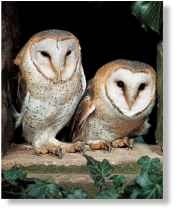
A Building a future
An old ruin is an ideal site for rearing the young.
Line-up
Chicks hatch at intervals and so vary in size.
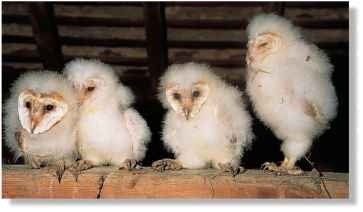
BEHAVIOR
During the day, the barn owl roosts in a barn, tree hollow or cave. Although it usually hunts in dim light or total darkness, it may occasionally hunt by day, when it relies on the sensitivity of its eyes. Its bone-chilling screams help distinguish it from other owls.
Superb hearing is key to its night hunting. Ears are offset on its skull to enhance stereo hearing, and two depressions flanking the bill on its dish-shaped face funnel the faintest sounds (such as a mouse chewing a seed) into the ear openings. By rotating its head, it can obtain an even more accurate fix on the source of a sound.
The owl needs a regular supply of food throughout the year. Winter is a particularly hard time — many small mammals are hidden from view. Many owls starve; only a quarter of young birds
survive their first winter. Some owls find extra food in winter by catching small birds leaving or returning to their roosts.

Landing gear Long legs swing forward as it alights on a perch.
FOOD & HUNTING
Through the night and for an hour or two before dusk and after dawn, the barn owl hunts by “quartering” the ground: flying slowly back and forth over a hunting patch, a few feet above the ground. It listens for noises that betray prey in the grass below. If it hears a sound, it drops slightly or hovers as it tries to trace it. Then it dives, or even somersaults backward, to attack.
As it hits the ground, it may spread its wings to steady itself.The owl eats its catch on the ground or carries it to a perch, such as a nearby fence post. Mice, small voles and shrews are staple prey, but the owl also takes rats, small birds, frogs, toads and even bats.
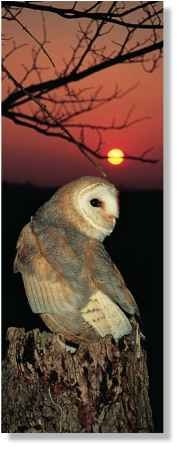
SILENT KILLER
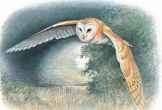
1 Listen…
By twilight or night, a hunting barn owl quarters the ground, its ears alert for the rustling of small mammals in the grass below.
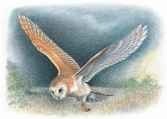
2 Dive…
Locating a sound, the owl slopes its wings and swoops rapidly upon its prey, remaining deathly silent in approach.
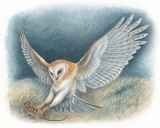
3 Catch…
The owl jerks its curved bill forward, swings its long legs down and spreads its feet. Sharp talons seize the prey in an inescapable, vicelike grip.
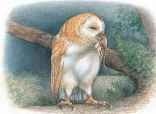
4 Devour
The owl kills with a swift bite to the neck. It eats the meal on the ground or carries it to a perch. Small mammals are eaten whole.
Profile
Barn Owl
Totally silent in flight and possessing incredibly sharp hearing, the barn owl is an efficient nocturnal hunter, particularly over grassland.
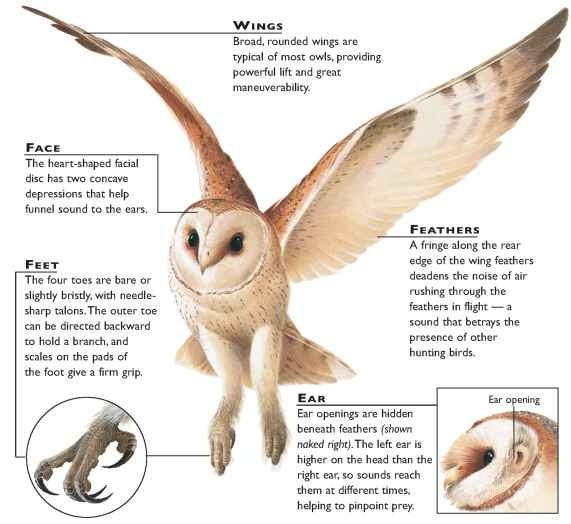
CREATURE COMPARISONS
The barn owl differs from other owls. It has smaller eyes and relies more on acute hearing, which is enhanced by its dish-shaped face.The barn owl also lacks the ear tufts of species such
as the great horned owl. Owls have hooked bills and sharp talons like eagles and kestrels, but aren’t related: the two groups have both simply evolved to hunt using the same basic method.

American kestrel

Barn owl
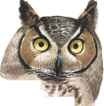
Great horned owl Tr?

Golden eagle
| STATISTICS | |
| Weight | 8-16 oz. |
| Length | 13-17″ |
| Wingspan | 34-37″ |
| Sexual 1 [Maturity | 1 year, sometimes 2 |
| Breeding Season | Late February or March to November in the Northern Hemisphere |
| Number of Eggs | Up to 20, but usually 4-7 |
| Incubation Period | 30-31 days |
| ; Fledging Period | 50-55 days |
| Breeding Interval | 1 year |
| Typical J Diet | Rodents, small birds, shrews, frogs, toads |
| Lifespan | Nearly 18 years |
RELATED SPECIES
• There are 35 known subspecies of common barn owl (in localized areas or island groups). Ten other species of the barn owl family live on grasslands, islands or in rainforest. A species from Indonesia may be extinct; others are rare. Family Tytonidae also includes two species of bay owl, genus Phodilus. The other 150 owl species belong to the family Strigidae: the hawk, or true, owls.

